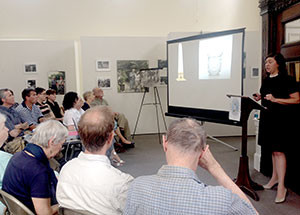
Corning Museum of Glass curator Kelly Conway delivered a fascinating lecture on the history of art glass production in Somerville on Sunday afternoon.
By Mariya Manzhos
When people want to learn about the past, the typical approach is through history books. But Kelly Conway, the curator of the Corning Museum of Glass in New York, prefers a much more tactile approach – examining historical objects themselves. And in her case, this means handling a lot of glass and learning its history. She shared her journey and discoveries with a presentation at the Somerville Art Museum this past Sunday.
“Glass makes history come alive for me. It’s a tangible connection with the past,” said Conway.
When Conway began studying American glass, her predecessor at the Corning Museum suggested that she explore the history of Somerville’s Union Glass Company. For over 75 years the company was an important producer of art glass in America, but little research had been done.
The story she tells begins with Amory and Francis Houghton, two members of the prominent Houghton business family, who decided to establish a glass company in Somerville, which was incorporated as the Union Glass Company in 1851. The factory was located on 52 Webster street and quickly grew into an extensive operation, comprising the three buildings of the factory, two furnaces, rooms for melting, molding, packing, cutting and every other step of the elaborate process. By the end of the 19th century the company employed roughly 200 workers, many of them immigrants from Italy, Sweden, England and elsewhere.
Union Glass produced a wide range of glass products, adapting to shifting fashions and economic conditions. Initially, Union Glass manufactured doorknobs, lamps and lamp trimmings, bottles, windows, lenses, and tableware. Railroad lanterns were also a significant source of revenue, as railroad workers would use lantern hand-signals to communicate with the engineer.
With increasing industrial wealth, tastes gravitated to more ornamented and decorated glass objects. One of the most famous objects created by Union Glass was a giant 150-pound punch bowl that was commissioned by Tiffany and Co. A team of 15 men spent 110 days meticulously cutting it. It was displayed in the Tiffany’s showroom in New York with a price tag of $3,000, which when adjusted for inflation would be about $77,000. Conway said that even today, that would be a bargain.
Unique objects made of silvered and iridescent glass, as well as pieces in the Venetian revival style distinguished the Union Glass Company on the glass market.
A special series strategically marketed to florists consisted of vases shaped and named after a variety of different flowers: Rose, Morning Glory, Sweet Pea and Carnation. Despite projects like these, the company’s bread and butter remained the production of high quality blanks, fully transparent glass pieces for engraving and cutting.
Production of art glass peaked during the ownership of the company by Julian deCordova, a merchant and investor of Jamaican heritage. Under his leadership the company survived the tumultuous 1880’s and stayed in Somerville, while most glass making companies were moving west for cheaper fuel and resources.
DeCordova was a consummate self-promoter, desperate to leave a lasting legacy. He was immensely proud of the American manufacturing landscape and Union Glass’s place in it.
The waning of interest towards iridescent and cut glass, as well as problems with internal management led deCordova to close down the factory in 1927. He donated 61 glass pieces to the Smithsonian while many remained in his home museum in Lincoln, MA until the Corning Museum acquired them.
Conway’s presentation about this piece of Somerville history was met with enthusiasm. Judy Neiswander, an independent glass scholar from Somerville, commented, “It always amazes me to see how the production of ordinary everyday objects for use reflects the social changes of the time.”
Conway echoed those thoughts: “When you start looking at objects you can see the evolution of big movements in every person’s household. Objects give you visual ideas about how people lived. When we have a visual object it becomes a human story.”















Reader Comments